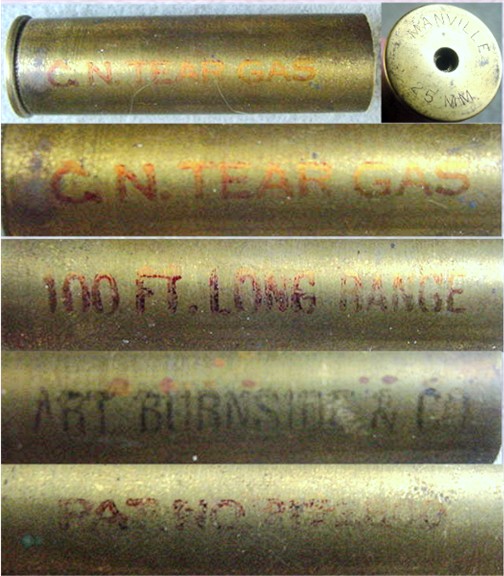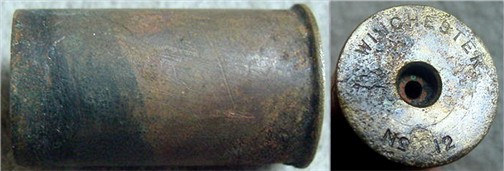| |
|
|
|
BRASS SHOT SHELLS – 10 GA., 12 GA., 8 GA. & 4 GA.
– WINCHESTER AND OTHER MAKERS: A good selection
of large gauge shot shells made of brass and other
metals by a variety of makers including Winchester.
These are perfect pieces to display with early shotguns
and their accoutrements, and they are in excellent
condition if you choose to reload them. If you’ve never
heard the definitive “THUNK” that sounds when one
of these large shells are dropped into the open breech
of an exposed hammer “street howitzer”, you’re missing
the full experience of owning an antique shotgun.
Each is listed below with accompanying photographs and
the price per shell.
In some cases I have multiple shells of the various
types, so if you wish to buy more than one, please
inquire when you place your order.
|
|
NO. 1 WINCHESTER BRASS 12
GAUGE "00 BUCKSHOT": Factroy loaded shell, full form and in excellent
condition. Shell measures
2 ½”
long. Have three
of these. (0328) $15.00 ea.

|
|
NO.
2
U.M.C. BRASS 10 GAUGE: Early Bridgeport
headstamp. Empty shell, full form and in excellent
condition. Shell measures 2 5/8” long. (0316)
$20.00
PENDING

|
|
NO.
3
U.M.C. BRASS 10 GAUGE "CLUB" HEADSTAMP:
Empty shell, full form and in excellent condition.
Shell measures 2 5/8” long. (0317) $10.00
PENDING

|
|
NO.
4
ALCAN ALUMINUM 4 GAUGE: Empty shell, full form
and in excellent condition. Shell measures 2 7/8”
long. (0327) $50.00

|
|
NO.
5
WINCHESTER BRASS 8 GAUGE: Full form and in
excellent condition. Shell measures 1 ½” long, is loaded
and primed with the wadding intact. (0326)
$50.00

|
|
NO.
6
MANVILLE BRASS 25 MM TEAR GAS SHELL: Empty
shell, full form and in excellent condition. Shell
measures 3 5/8” long. The sides of the shell
are stamped with the shell content, range warning,
manufacturer name and patent information. The
Manville headstamp identifies this cartridge as one for
the "Manville Gun", a stockless, semi-automatic,
revolving gun introduced by Charles Manville in 1935.
The gun featured a heavy cylinder which rotated with
each shot, functioning on a clock work type spring which
was wound manually during the reloading process.
In 1938, Manville introduced three calibers for the gun
- 12 gauge, 25 MM, and 37MM. Manville ceased
production of the gun in 1943. The Art Burnside
Company was a supplier of police equipment located in
Spokane, Washington and was in business prior to World
War Two. (0326) $80.00

|
|
NO.
7
WINCHESTER BRASS 12 GAUGE: Empty shell, full
form and in excellent condition. Headstamped with the
larger font "WINCHESTER". Shell measures 2 5/8”
long. Have a few of these. (0318)
$8.00

|
|
NO.
8
WINCHESTER BRASS 12 GAUGE: Empty shell, full
form and in excellent condition. Headstamped with the
early small font "WINCHESTER". Shell measures 2
5/8” long. Have two of these. (0319)
$10.00

|
|
NO.
9
WINCHESTER BRASS 12 GAUGE - SHORT SHELL: Full
form and showing some wear on the head, this is a short
version shell, measuring 1 ½” long.
. Headstamped with the early small
font "WINCHESTER". (0320) $8.00

|
|
NO.
10
REMINGTON-UMC "BEST" BRASS 12 GAUGE: Empty
shell, full form, but showing some minor misshaping
around the mouth of the shell that could be easily
reformed. Shell measures 2 ½” long.
(0323) $5.00

|
|
NO.
11
DUTCH ALUMINUM 12 GAUGE: Loaded shell, full
form, in excellent condition. Headstamped with a
powder horn logo, and "Made in Holland" with the gauge
designation. The over shot card is printed with
"7", indicating the shot size. Shell measures
2 ¼” long. (0324)
$5.00

|
|
NO.
12
HORTON GLASGOW BRASS-PAPER LINED 12 GAUGE:
Loaded shell, full form, in excellent condition.
Headstamped with "HORTON GLASGOW" and the gauge
designation. The over shot card is printed with
"6", indicating the shot size, and the legend "AMERICAN
AMMUNITION". Shell measures
2 ¼” long. (0321)
$10.00

|
|
NO.
13
NOBEL-GLASGOW BRASS-PAPER LINED 12 GAUGE: Fired
shell, full form, in very good condition.
Headstamped with "NOBEL-GLASGOW" and the gauge
designation. The paper liner is fully intact.
Shell measures
2 ¼” long. (0322b)
$5.00

|
|
NO.
14
CHARLES ROSSON DERBY BRASS-PAPER LINED 12 GAUGE:
Same shell as No. 13, with a different headstamp -
"CHARLES ROSSON" over "DERBY" and the gauge designation.
Fired shell, full form, in very good condition.
The paper liner is fully intact. Shell measures
2 ¼” long. (0322a)
$5.00
|
|
NO.
15 WINCHESTER BRASS 10
GAUGE: Empty shell, full form and in excellent
condition. Shell measures 2 7/8” long. Have a few
of these. (0315) $15.00 PENDING
 |
|
|

